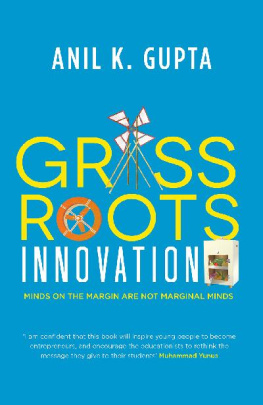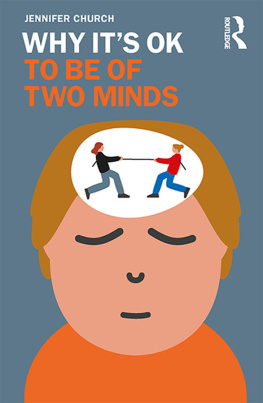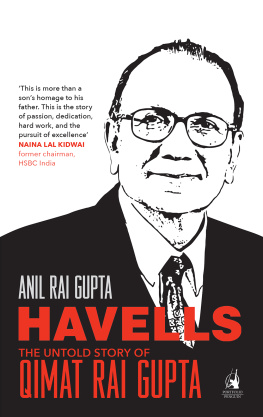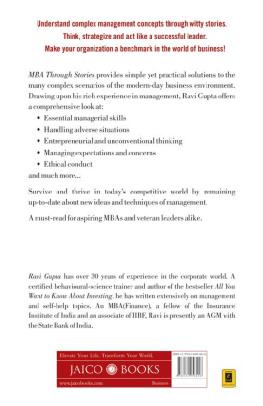ANIL K. GUPTA
GRASSROOTS INNOVATION
Minds on the Margin are not Marginal Minds
CONTENTS
Praise for the Book
Professor Anil Gupta has proved with his empirical research that human beings are innately innovative and entrepreneurial. I cannot agree more. I invite young people to tell themselves this, We are not jobseekers, we are job creators and act this way. I am confident that this book will inspire youngsters to become entrepreneurs and encourage educationists to rethink the message they give their studentsProfessor Muhammad Yunus, Nobel Peace Prize laureate and founder, Grameen Bank
Professor Gupta has made seminal contribution to pushing our country towards becoming an Innovating India. He is almost single-handedly creating a national ecosystem to nurture grassroots innovations, and this book provides glimpses into how he has been devoting his boundless energies towards what he has taken to be his sacred callingDr Vijay Kelkar, chairman, Thirteenth Finance Commission; chairman, National Institute of Public Finance and Policy
Stating from personal experiences, Anil Gupta weaves the remarkable narrative of a journey that placed traditional knowledge and grassroots innovations on the national agenda. It is also a story of institution-building, the uncertain processes that it involves and the conflicts it creates. Full of insights, the book is an inspiring work from a person who has passionately devoted his life to highlighting the knowledge of those whom society treats as marginals. Guptas book is a major accomplishment that will interest scholars, social activists and the general public alikeKuldeep Mathur, reputed author on public policy and administration; former professor at JNU
Professor Gupta is globally heralded today as the father of the inclusive innovation movement, which he started more than three decades ago. His firm conviction that minds on the margin are not marginal minds lights up every page of this inspiring book. His fascinating journey is filled with great milestonesright from setting up the Honey Bee Network to SRISTI, the National Innovation Foundation to the Festival of Innovation. This is indeed a fascinating story of realizing the dream of democratization of innovation of one of the most iconic innovation leaders of India, told in his own inimitable style. To me, it is a must-readDr R.A. Mashelkar, president, Global Research Alliance; chairman, National Innovation Foundation; former director general, Council of Scientific and Industrial Research
This book demonstrates that innovation is an intrinsic attribute of the human spirit everywhere. It serves as a powerful inspiration for governments to support creativity where it matters most, at the grassroots. I recommend it for anyone interested in improving human well-beingProfessor Calestous Juma, Harvard Kennedy School, Cambridge, USA
Continuing the Gandhian tradition of padayatrawalking together with farmers, artisans, mechanics, students and scholars through villages in the interiors of the countrythese shodhyatras have created a new idiom of authentic dialogue between the formal and informal sectors in our country. This book will convince anyone still not convinced about the innate creativity and innovative potential at the grassroots. Those in the organized sector, I believe, will find inspiration to join hands as equals with our knowledge-rich poor peopleEla Bhatt, founder, Self-Employed Womens Association of India
My life turned from being an exploiter in the knowledge market to perhaps a more benign actor, thanks to the thousands of grassroots innovators who taught me how many economically poor people solve community problems and openly share these creative solutions.
May these teachers, grassroots leaders and social innovators reinforce our faith in the future.
Introduction
Be a Bee
S owing the seeds of the grassroots innovation movement twenty-six years ago was a cathartic moment. The search for authentic expression in a world where short-changing knowledge creators and providers is the norm was not easy. But, thanks to thousands of farmers, artisans, pastoralists, students, scholars and many well-meaning policymakers, the movement gained momentum. Slowly but steadily, communities of practitioners, professors and other stakeholders began to recognize the need for reciprocity in a responsible and respectful way towards the knowledge-rich but economically poor people. Commitment towards an uncertain future requires not just faith but also a capacity to cherish fuzziness. I have had a job as an academic and therefore the uncertainties I faced were less consequential for my material survival. But those colleagues who worked with me in taking this initiative forward by showing enormous willingness to pursue a path not traversed so far risked far more. I cannot thank these colleagues enough. Each one of them has given, and many more are still giving, a very precious part of their life to sustain this movement. May their tribe increase.
The contribution of farmers who have walked with me for thousands of kilometres all over the country, despite troublesome terrains and severe conditions, is unparalleled in the history of recent social movements. To some, there seemed no reason to walk through conflict-torn regions as a part of the shodhyatras. But if we listen to those who are angry and upset with the current social arrangements, only then will the legitimacy of these arrangements come into question. Pursuing a non-violent path of change is imperative. But one can persuade others to follow such a path only when we listen to those who dont agree with us. We must try to do that patiently. We often argued that we may not have been able to support the disadvantaged people in their struggles around jal (water), zameen (land), jungle, but we could certainly tilt the scales in their favour in the struggle around jaankari (knowledge). The Honey Bee Network is a manifestation of this solidarity with the minds on the margin, who are not marginal minds.
I have shared several personal anecdotes from my life while narrating the story of the grassroots innovation movement. It is only to illustrate that our personal evolution is often intertwined with our professional predicaments and values. It is difficult to separate the two.
It is also possible that the institute that I have been teaching at for the last thirty-five years may not figure as prominently in the narrative as it deserves. There are few institutions which provide more freedom, flexibility and fellowship than what the Indian Institute of Management, Ahmedabad (IIMA) has provided to me. Thank you, IIMA, for making this movement possible.
The story of how Amrutbhai Agrawat, a blacksmith in a village of Gujarat, tried to solve numerous social challenges through his creativity and innovation reverberates in almost every single instance of grassroots innovations. Having lost his father, he was brought up by his mother, a farmworker. None of his struggles ever dampened his spirit. His children are carrying forward the same spirit of social innovation. He was one of the first innovators we came across when we started this journey. His recent stay at the Rashtrapati Bhavan as an innovation scholar, hosted by the office of the President of India, is testimony to the journey the Honey Bee Network has pursued so far. Many times, people ask how many innovations have reached how many million people. A valid question, except that it betrays the case for the long tail of innovation. If we were to ignore these niche-specific solutions, a lot of communities would be neglected, bypassed and alienated. There is nothing more dangerous for democracy than making a lot of the communities distributed around the world feel that their unmet needs are of no concern to those who matter. A distributed, networked, shared economy requires a large number of flowers to bloom and not necessarily of the same species and stock. Diversity is the essence of inclusiveness and creativity.












